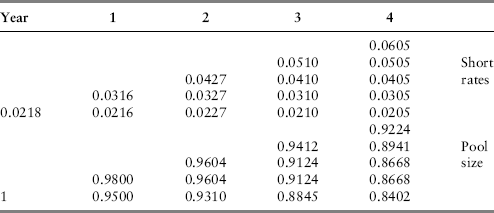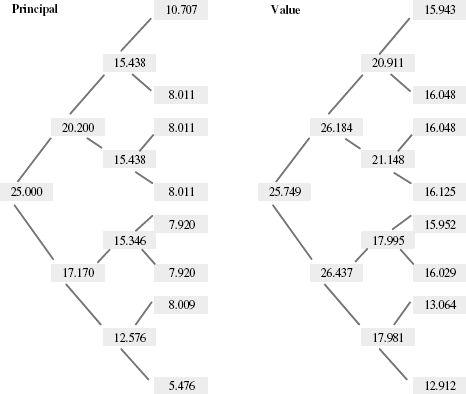CMO Valuation
Consider an allocation to the investment grade AAA tranche of a CMO. This tranche (call it tranche A) is entitled to 25 percent of the principal and interest on a pool of mortgages consisting of prime and subprime loans that have been structured so as to enhance the credit ratings within the pool, using methods discussed at the beginning of the chapter. To keep things simple, let's refer to tranche A as a single bond and assume that this bond is priced in the market at 103. Is this a fair price?
To price this bond, we first need some facts. First, let's assume that it is August 1, 2008, and that the term structure is a presented in the Ho-Lee and BDT models. Furthermore, assume that 2 percent of the loan pool is prepaid annually except when short rates fall, in which case the prepayment rate rises to 5 percent. The average mortgage rate on the pool is 4 percent. Using the template from Chapter 2, we estimate that the conventional 30-year annual mortgage payment is $5.78 per hundred dollars and that annual interest on this tranche is 25% × 0.04 = $1. Let's assume that tranche B is entitled to 50 percent of the principal and interest in the CMO, and a third tranche C is entitled to 25 percent. Tranche C is subordinated to the first two tranches and receives no payments until tranches A and B are retired. Tranche A received principal and interest first, while tranche B is paid interest only until tranche A is retired. Tranche C accrues interest until the first two tranches are retired. Thus, tranche C carries the highest risk in the event there are defaults. It also carries the highest interest rate risk in the event that prepayment rates exceed expectations.
To minimize labor while maximizing intuition, we will price the tranche A bond going out three years. Figure 20.8 therefore borrows the first four nodes from Ho and Lee and appends a matrix indicating the remaining pool size consistent with our earlier assumptions concerning prepayments. (See the chapter spreadsheet for all computational details.)
Figure 20.8 CMO Valuation Using Ho-Lee

The pool size reflects the remaining principal conditional on the movements in the short rates in the top half of the table. Our first task is to keep track of the principal due to tranche A, which begins with 25 percent at time zero but is diminished as principal and interest are paid from the pool. The computations are given in the chapter spreadsheet, but here is the intuition: the remaining principal is equal to the previous principal, which grows at 4 percent per year (the mortgage rate) but is decremented by the impact of the reduction in the size of the pool each year. The declining pool size affects both the current year principal as well as the remaining principal in the other tranches. Thus, while the discount factors in the short-rate lattice have no direct impact on the remaining principal, they do have an indirect impact through prepayment behavior. Thus, assumptions about prepayments will drive part of the CMO pricing.
Our second task is to discount the cash flows associated with each principal amount at each node, and working backward, arrive at the present value of the bond. Again, refer to the spreadsheet for computational details. Values for the terminal nodes reflect the discounted value of the principal associated with that node, itself conditioned on the matched short rates and pool size. Values for interior nodes reflect the average discounted values of the two subsequent nodes based on the principal amount that node is entitled to. Figure 20.9 shows the principal and value for this tranche.
Figure 20.9 Principal and Value for Tranche A

The value of the bond is therefore $25.75. A final computation indicates that this bond would sell at 25.75/25 = 103, relative to par. Thus, the bond is fairly priced, according to our model.
